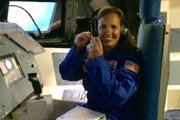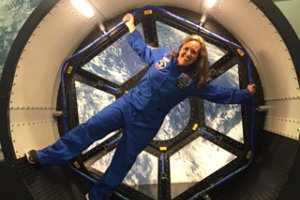Reframe Podcast: Episode 26

Space Camp

James Loy:
This is Reframe, The podcast from the College of Education, Health and Society on the campus of Miami university.
Last time, we talked to an EHS doctoral candidate and Ohio superintendent about the challenges of managing educational policy. And in the end, he said, it’s not really the policies that will ultimately make a real difference. But rather it’s the quality of people who actually work in schools.
So in this episode, we have a story about an exceptional educator, who literally participated in an “out of this world” experience, and all for the benefit of her students.
(MUSIC FADE)
When a colleague suggested she apply for the prestigious and extremely selective Honeywell Educators Space Camp program, she thought it might be a long shot. But a fear of failure is not something that bothers Jackie O’Brien.
Jackie O’Brien:
And I thought there is no way they are going to accept me for this. I thought I don’t know if it’s going to happen. But I thought we’ll try it.
James Loy:
A graduate of Miami University’s College of Education, Health and Society, O’Brien is an educator at Indian Hill Elementary School in Cincinnati, where she is currently creating a new STEM curriculum to focus on science, technology, engineering, and math.
And it’s also where she regularly teaches 3rd, 4th, and 5th graders about the importance of STEM, critical thinking, problem solving, collaboration, and, yes, even the merits of failure.
Jackie O’Brien:
A big part of my class is talking about failure and knowing that you’re not always going to get something correct the first time that you do it. But it is all about the perseverance. And why does it not work, and questioning it, and what could I do differently. And that’s the biggest thing I want my students to learn.
James Loy:
So when the chance to attend space camp arose, she didn’t hesitate. She took a chance and gave it the best effort she could.
And it turns out, and perhaps not surprisingly, that Honeywell was also looking for the same kind of perseverance and grit and passion for science that O’Brien wants her own young students to embrace. So when the acceptance letter actually came, she was pretty excited.
And for a pretty good reason too.
Every year, Honeywell Educators Space Camp receives over 3,000 applications from a global audience of teachers who all hope to be among the few selected to join the intensive program.
In fact, O’Brien was one of just 108 teachers from 45 states and 33 countries who also attended the U.S. Space and Rocket Center during her week-long visit, which included real astronaut training, lab experiments, numerous scenario-based simulated space missions, and much more.
The entire program is designed around one goal: To help educators like O’Brien create even more dynamic and engaging science-based learning environments within their own classrooms back home.
Jackie O’Brien:
I got to do the multi-axis trainer and different astronaut simulations and then go to Mars and go to the Moon. And . . . so on top of all the things that the space campers get to do, there are also other teacher resources and lessons and things that we got to do, that we could then bring back to our schools and do with our students.
James Loy:
The space camp takes the idea of professional development to an entirely new level. And the networking opportunities are tremendous as well, especially considering the breath of international perspectives O’Brien also gained by meeting other passionate STEM teachers from all around the world.
Jackie O’Brien:
It was absolutely incredible. Just being able to talk to them about their educational system, and things that they do, and also just learn more about their culture, and just hearing about how they teach STEM, and how their districts are run, and how I have this network of other teachers, who we can bounce ideas off of. We are still connected through Facebook and different things.
James Loy:
So now, after her intensive and what she calls “life changing” training, O’Brien is back home again and she’s ready to use her new educational tools and resources to continue improving her new STEM curriculum by introducing more Earth and Space Science standards to enrich classroom projects.
Plus, after being interviewed by a leading Cincinnati TV station, she’s also become somewhat of a local science celebrity.
Jackie O’Brien:
It was fun when the students were starting and saying, ‘Ms. O’Brien, I heard about you and saw you on the news!” I got my own blue flight suit when I was down there. So when I am teaching my STEM classes every Friday – I have a new group of kids every week – So every Friday I . . . usually every Friday, I wear my flight suit and I call it “Flight Suit Friday.” So I get to wear that, they get to see it, and it’s fun. I think they enjoy it.
James Loy:
But more importantly, she says, is that they are also starting to really enjoy science. And the newfound excitement and enthusiasm she’s generating is directly related to her space camp experience, which her students also benefit from simply by being in her class.
Jackie O’Brien:
When I think about kids having the opportunity to go to different camps and I remember when I was younger thinking, wow, that space camp sounds pretty amazing. And then never having the opportunity to do it. You know, if a kids goes, then they have that experience. That’s one child. But if you send a teacher to a space camp, I have that knowledge, so then it’s kind of that ripple effect. So, you know, you send a teacher and there I go. But then I also . . . you know, I have about 500 students in this building that I then have an opportunity to go and work with and teach and share my knowledge with. So I think that was the biggest impact for me. It wasn’t just one student goes and has an experience. But as a teacher, I go and I am now able to share that information with all of my students in the building.

